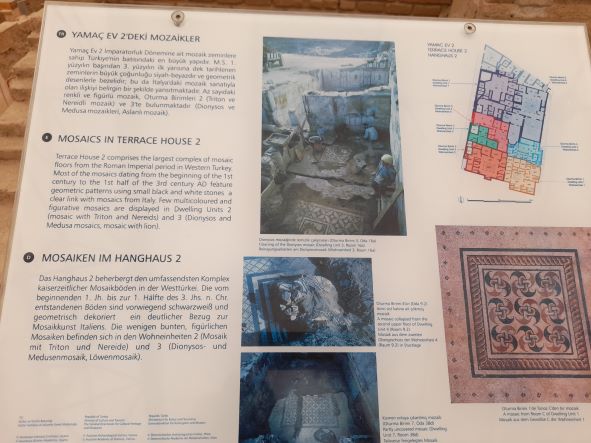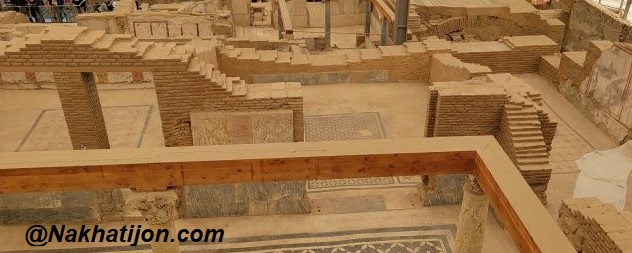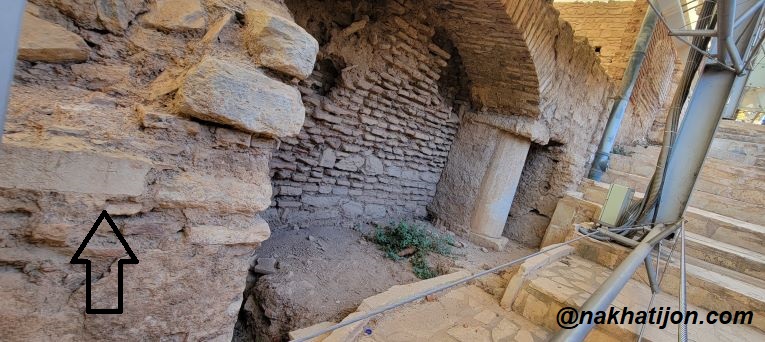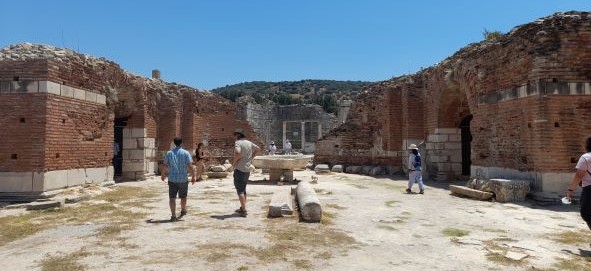- Hidden Crosses at the Seljuk Castle near Ephesus
- Walking by Hidden Crosses in the Churches of Ephesus
- Finding the Hidden Savior on Mary’s Knee
In touring the ancient site of Ephesus in Seljuk, Turkey, one can observe the different stages of church development. Unfortunately, many tourists often miss the cues demonstrating the church’s growth in this remarkable ancient site. Let’s look at what remains of the churches of Ephesus.
Public Space Gatherings
Acts 19:8-10 declares that the Apostle Paul came to Ephesus and spoke three months in the synagogue, “reasoning and persuading them about the kingdom of God. 9 But when some became stubborn and continued in unbelief, speaking evil of the Way before the congregation, he withdrew from them and took the disciples with him, reasoning daily in the hall of Tyrannus.” He continued to meet daily for “two years so that all the residents of Asia heard the word of the Lord, both Jews and Greeks.” Opposition came from his time in the synagogue, so Paul moved to the Hall of Tyrannus.
This hall was presumably a public or semi-private hall owned by Tyrannus. This man, influenced by Paul’s preaching, allows him to use the hall for two years to disciple the first gathering community in Ephesus. Quite likely, continuing the initial gathering that Apollos started (Acts 18:24-28) and working alongside Priscilla and Aquila, these meetings gave an opportunity for public meetings of the church. Many speculate that this hall existed in the Agora area and was used mid-day by Paul after the morning lectures by Tyrannus or other teachers.[1]https://www.biblegateway.com/resources/encyclopedia-of-the-bible/Tyrannus The public Agora sits left of the large Theater (hidden in the pic below) in the former square between the Theater and the northern exit from the Celsus Library. So when heading toward the Theater from the Library, the area on the left was the Agora.[2]https://www.ephesusturkey.com/ephesus-highlights/state-agora/ In all likelihood, Paul labored in this area to pay for the expenses of the hall when he made tents with his hands (Acts 20:34).

Re-Purposed Space Church
When one walks through Ephesus, crosses on the pillar’s stylobates (base section), capitals (upper section of a pillar), and friezes (ornament section depicting images) lay near the walkways. After the Edict of Milan (313 A.D.), the church in Ephesus gained some new freedoms. The 4th-century churches re-purposed public spaces such as former temples and halls to enable the believers to gather. These crosses discovered near where they lay depict where some of these spaces existed. The original civic or religious buildings, not made as churches, lost their previous use. The Christians used these locations, especially in the 5th-6th century, placing a cross on capital columns or the base areas to demonstrate their religious service. These early believers only demonstrated their faith by crosses, not incorporating statues, icons, or public displays of scriptures.


Terrace House Churches
House Church in the Terrace Houses – These dwellings from the 2nd to 7th century provide a unique glimpse into the life of wealthy families in Ephesus.[3]https://turkisharchaeonews.net/object/terrace-houses-ephesus The courtyards, mosaics, and living spaces characterize the period and how closely even the rich lived together.


As one walks through the Terrace Houses, not much Christian symbolism seems to exist. Yet below one of the upper glass floors (near Terrace House two), an exciting display appears. Two-entryway stone crosses lay in one of the sections on the ground below the glass (pic above). Historically these entryway stones were placed on each side above door frames. The size of these cross-displays depicts an entry to a room, more than a large building. These were most likely used during the later period of these houses.
Mosaic Hints in Terrace Houses

This description on the left mentions the mosaics in Terrace House Two as coming from Italy, which could mean the Roman secular designs or the influence of Christianity. Mosaic designs had a wide range of influence, yet notice the multiple types of cross-like geometric shapes. The Christian faith influenced the artisans in Ephesus. The Terrace houses represent an exciting glimpse into community life and how 4th and 5th-century wealthy individuals desired to demonstrate their beliefs.
The mosaics here and in the lower walkway in the shop area outside the Terrace houses display similar symbols. The heart symbols (agape love) are similar to those on the floor of the Laodicea Central Church and St. Mary’s Church on the north side of Ephesus. Again, the fluidity of influences on mosaics varies quite a bit, and the diversity in the houses resembles the Byzantine palace mosaics in Istanbul.[4]https://muze.gen.tr/muze-detay/mozaik The subtle influence of Christianity by artisans who came to Christ over the centuries gives us a hint as to what happened in the centuries that followed the riot of the city guilds during Paul’s day (Acts 19:23-27).
These three rooms in the upper area of the enclosed museum display floor mosaics with geometric designs that resemble crosses, interestingly avoiding any Greek images. The mosaics in these rooms avoid idolatry or political intents, displaying one geometric design – the cross. The followers of The Way (Acts 19:9) now walked on floors presenting Christ’s sufferings.

House Church Signage

After one leaves the enclosed area, going down the steps from the Terrace Houses, a former entryway resides on the right. On the left side of this entryway, a cross displays on the flat white stone, possibly marking an external entry into the house church area. The other side of this wall is near where the two-entryway stone crosses sit below the glass.
Public Church Building
The St. Mary Church, just west of the lower exit/entrance of the site, often neglected by tours, provides a peek into the state of the church from the 4th to the 6th century. Previously, I thought this site was the house of the Virgin Marys in the town of Seljuk, but that site lies outside of the ancient city. The first stages of this historical church possibly precede the Byzantine Empire (started in 330 A.D.). As the harbor receded, the city used the northern side of the public Agora for religious worship, and possibly the first use of this area came after the Goths destroyed parts of the city (262 A.D.); during that time, the temple of Artemis was destroyed[5]https://www.history.com/topics/ancient-greece/ephesus
The 260 meters long church shows various sections of this ancient church, which present a few walls from the 3rd to 5th century and later walls of the Byzantine period.[6]http://www.ephesus.ws/the-church-of-virgin-mary-ephesus.html The early believers of Asia Minor constructed church buildings facing East, and these remains present two different eastern apses (semi-circle seated areas for ministers) that faced the rectangle nave of the worshippers. The site boggles the mind with the size of the area. Across the street from this area is the excavated Bishop’s house which nature has again covered up. This large house and courtyard could host gatherings, demonstrating this church’s importance to the city and the region. A few historic meetings, such as the council of Ephesus (431 A.D), were held in this church area.[7]https://turkisharchaeonews.net/object/church-virgin-mary-ephesus

Empire-built Church
The St. John’s Basilica, on the Seljuk hilltop, represents the last stage of Churches in Ephesus as the city moved toward modern-day Seljuk. Based on tradition, the site formerly hosted the tomb of the Apostle John. Empire Justinian I renovated this massive structure in the 6th century, expanding an older church on the mound. As a result, the courtyard, pillars, and walls boast one of the most flourishing sites depicting the cross. On one of my visits there, a group of Romanian Orthodox believers surrounded the nave area, touching the pillars marked near the former tomb, as their guide recounted the life of John.
On touring Ephesus, please do not miss the stages of the ancient churches of Ephesus. The early believers, especially in the 4th century, used public space, house churches, and general church buildings, demonstrating Ephesus’ phases of church growth. The words of Acts 19:20 prophetically said about Ephesus, “So the word of the Lord continued to increase and prevail mightily.”[8]Updated 17 October 2022
References
| ↑1 | https://www.biblegateway.com/resources/encyclopedia-of-the-bible/Tyrannus |
|---|---|
| ↑2 | https://www.ephesusturkey.com/ephesus-highlights/state-agora/ |
| ↑3 | https://turkisharchaeonews.net/object/terrace-houses-ephesus |
| ↑4 | https://muze.gen.tr/muze-detay/mozaik |
| ↑5 | https://www.history.com/topics/ancient-greece/ephesus |
| ↑6 | http://www.ephesus.ws/the-church-of-virgin-mary-ephesus.html |
| ↑7 | https://turkisharchaeonews.net/object/church-virgin-mary-ephesus |
| ↑8 | Updated 17 October 2022 |
[…] Ephesus moved into the area of modern Seljuk, so did the church. This Seljuk Castle Basilica shows the […]